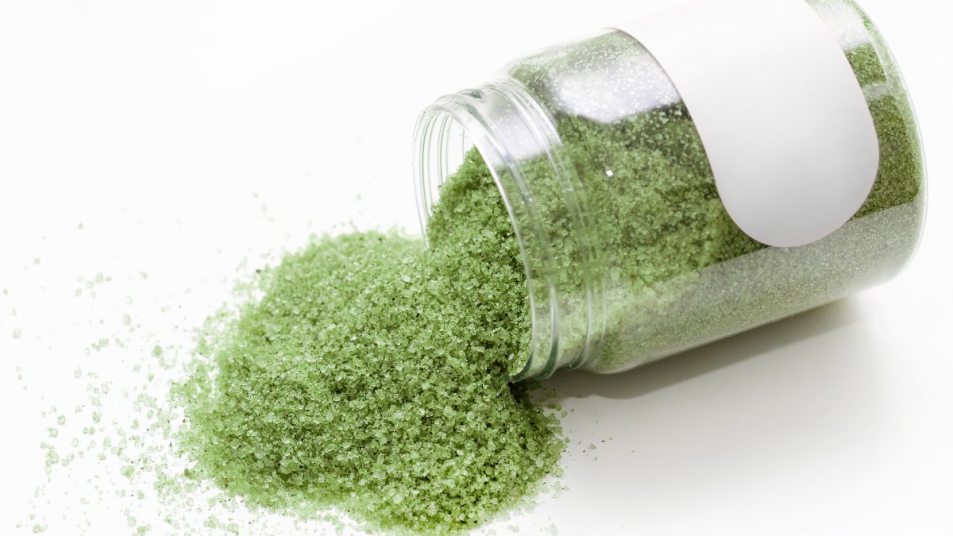Are you trying to reduce your sodium intake? Going cold turkey can be a difficult task. Processed foods and restaurant meals contain high amounts of salt, and cooking without salt at home presents challenges for family members who enjoy the taste. Fortunately, there may be a simple solution: green salt.
The internet is full of talk about this alternative to table salt. Maybe it’s because it’s so unusual. The product is powdery and green, sold in a brown paper bag (as opposed to a traditional grinder or salt tub), and comes with several extra nutrients, including magnesium, potassium, chlorophyll (hence the green color), vitamin B3, iodine, some protein, and fiber. But is it worth buying?
What is green salt?
The green salt is dehydrated Salicornia, or sea asparagus. sea asparagus has many other names — pickleweed, glasswort, navy beans, goosefoot leaves, hamcho and samphire – all of which describe a fleshy, rod-shaped plant that grows in salty wetlands, marshes, and seacoasts. It has long been used in korean foods (as a flavor enhancer) and traditional medicine (as a treatment for poor digestion and diabetes).

To make green salt, sea asparagus is dehydrated and then ground to a fine powder. The nutrients it contains come directly from the plant; nothing else is added to the product.
What are the benefits of sea asparagus?
Some research shows that sea asparagus (Salicornia) has anti-inflammatory and antioxidant qualities. For example, a 2009 study by the Journal of Medicinal Foods found that Salicornia extract had antioxidant properties in laboratory experiments. A 2022 study published in antioxidants showed that the antioxidants in Salicornia were effective in reducing inflammation in certain white blood cells.
Additional research suggests that sea asparagus has anti-diabetic properties. A 2008 study of the Korean Journal of Microbiology and Biotechnology found that a specific nutrient in the plant (known as SP1) was linked to better regulation of sugar and insulin in diabetic rats.
Another study published in Food and Function in 2015 tested the effects of Salicornia salt on blood pressure in rats. The researchers fed one group of rats traditional table salt and another group Salicornia salt (in the same amount). They found that Salicornia salt did not raise blood pressure while table salt did. In fact, Salicornia salt even had a protective effect on the kidneys and livers of rodents.
Of course, the results of animal studies should be taken with a grain of salt (no pun intended!). The experiments were done on rats, not humans, so more research needs to be done to support these findings. Still, the research on sea asparagus so far is promising.
What does green salt taste like?
According to YouTuber Chris Hamilton, who reviewed the product from TryGreenSalt.com earlier this year, “it’s salty but not ultra salty.”
Hamilton admits that it doesn’t quite taste like salt. “It’s got a little, a little bit of a shellfish flavor to it because it’s…apparently from a salt marsh near the sea,” he shares. But I’ts not bad. You probably have to use a lot to satisfy that super craving for salt.”
In other words, you can effectively eat the same amount of sodium if you add two shakes of green salt where you would normally add one shake of table salt. However, this comes down to diligence. Hamilton believes that green salt is a good transition tool away from regular salt. He recommends filling a salt shaker with equal parts table salt and green salt to start.
As a bonus, the Green Salt company says the flavor is mild enough to bake with. Just be aware that some baked goods can turn a bit green!
What is the final conclusion?
So is it worth buying green salt? A 9-ounce bag is $22 (Buy at TryGreenSalt.com). That’s a high price to pay when regular iodized salt it costs 40 cents for 26 ounces. Still, it can help you reduce your sodium intake without having to go cold turkey, and the added nutrients can improve your health. So it might make sense for you to try sea asparagus.
We write about products that we think our readers will like. If you buy them, we get a small part of the provider’s revenue.
